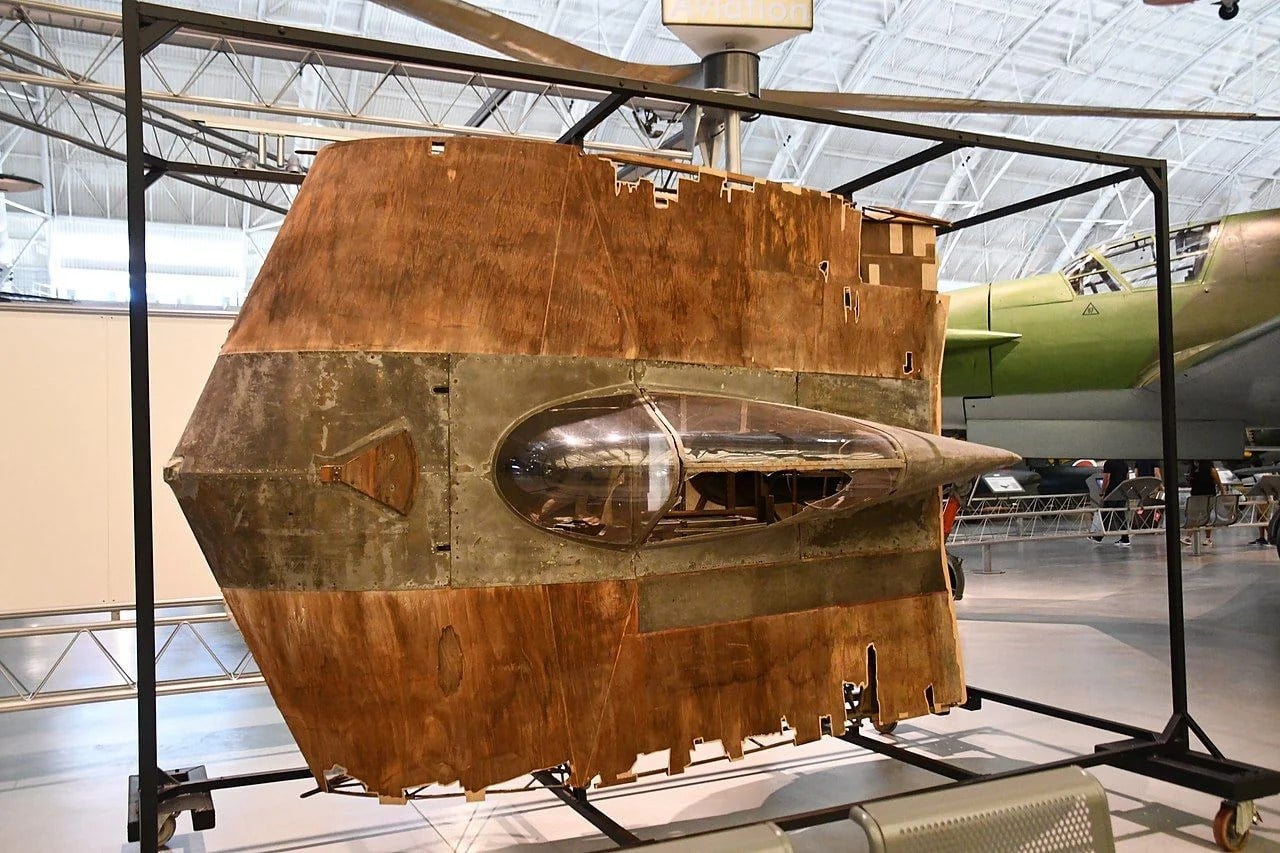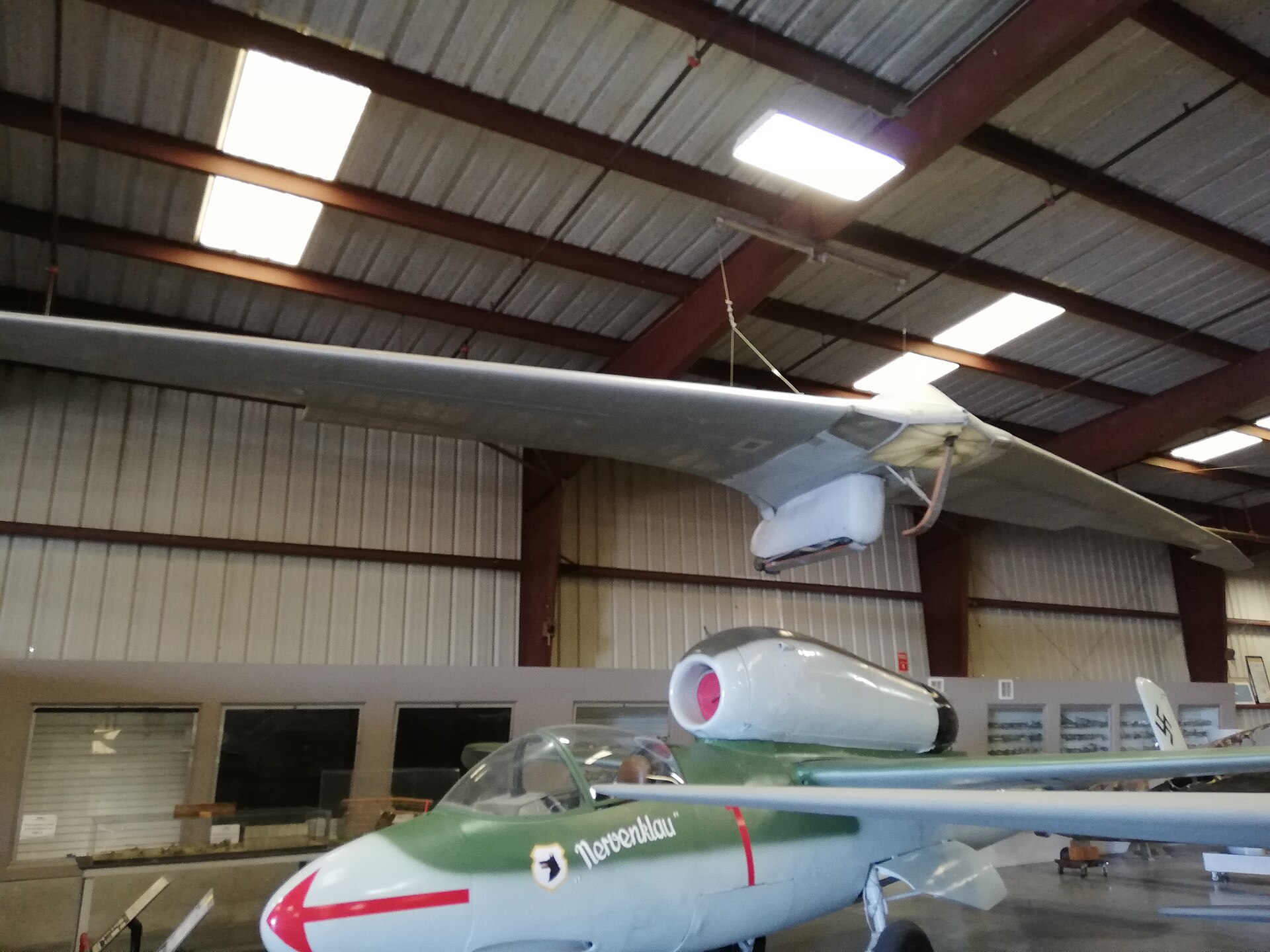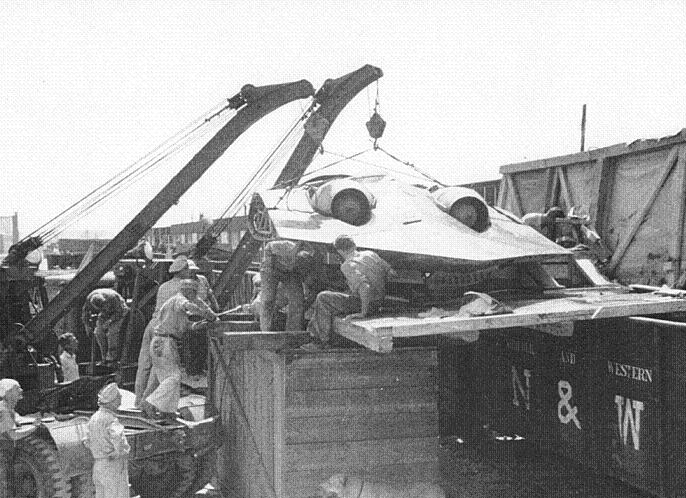Northrop
Grumman B-2 Spirit,
also known as the Stealth Bomber, is an American heavy penetration
strategic bomber, featuring low observable stealth technology designed
for penetrating dense anti-aircraft defenses; it is a flying wing
design with a crew of two. Produced 1987–2000.


In a 1994 live fire exercise near Point Mugu, California, a B-2 drops
47 individual 500 lb (230 kg)-class Mark 82 bombs, which is more than
half of a B-2's total ordnance payload. (CC, Public Domain)

The Horten H.IX, RLM aircraft designation Ho 229 (or Gotha Go 229 for extensive re-design work done by Gotha to prepare the aircraft for mass production) was a German prototype fighter/bomber initially designed by Reimar and Walter Horten to be built by Gothaer Waggonfabrik late in World War II. It was the first flying wing to be powered by jet engines. Horten Ho 229-.
The German Air Ministry
(Reichsluftfahrtministerium; RLM) had a system for aircraft designation
which was an attempt by the aviation authorities of the Third Reich to
standardize and produce an identifier for each aircraft design's
airframe type produced in Germany. It was in use from 1933 to 1945
though many pre-1933 aircraft were included and the system had changes
over those years. As well as aircraft of the Luftwaffe, it covered
civilian airliners and sport planes, due to the RLM handing all
aviation-related matters in the Third Reich, both civilian and military
in nature. - RLM
aircraft designation system.


この像(Horten Ho 229)はお そらく実物の写真を使った合成写真(想像図)である。/右は実物
| The Horten H.IX, RLM designation Ho 229
(or Gotha Go 229 for extensive re-design work done by Gotha to prepare
the aircraft for mass production) was a German prototype fighter/bomber
designed by Reimar and Walter Horten to be built by Gothaer
Waggonfabrik. Developed at a late stage of the Second World War, it was
one of the first flying wing aircraft to be powered by jet engines.[1] The Ho 229 was designed in response to a call made in 1943 by Hermann Göring, the head of the Luftwaffe, for light bombers capable of meeting the "3×1000" requirement; namely, to carry 1,000 kilograms (2,200 lb) of bombs a distance of 1,000 kilometres (620 mi) with a speed of 1,000 kilometres per hour (620 mph).[2][3] Only jet propulsion could achieve the required speed, but such engines were very fuel-hungry, necessitating considerable effort across the rest of the design to meet the range requirement. The flying wing configuration was favoured by the Horten brothers due to its high aerodynamic efficiency, as demonstrated by their Horten H.IV glider. In order to minimise drag, the Ho 229 was not fitted with extraneous flight control surfaces. Its ceiling was 15,000 metres (49,000 ft).[4] The Ho 229 was the only design that came close to the requirements, and the Horten brothers quickly received an order for three prototypes after the project gained Göring's approval. Due to the Horten brothers' lack of suitable production facilities, Ho 229 manufacturing was contracted out to Gothaer Waggonfabrik; however, the company allegedly undermined the project by seeking the favour of Luftwaffe officials for its own flying wing design.[citation needed] On 1 March 1944 the first prototype H.IX V1, an unpowered glider, made its maiden flight, followed by the H.IX V2, powered by Junkers Jumo 004 turbojet engines in December 1944. However, on 18 February 1945 the V2 was destroyed in a crash, killing its test pilot. Despite as many as 100 production aircraft being on order, none were completed. The nearly complete H.IX V3 prototype was captured by the American military and shipped to the United States under Operation Paperclip. It was evaluated by both British and American researchers before entering long term storage. The H.IX V3 is on static display in the Smithsonian National Air and Space Museum. |
ホルテン H.IX、RLM 指定番号 Ho
229(または、ゴータ社による大量生産に向けた大幅な再設計作業のため、ゴータ Go
229)は、ゴータ社で製造される予定だった、ライマーとヴァルター・ホルテンが設計したドイツの試作戦闘機/爆撃機である。第二次世界大戦の末期に開発
された本機は、ジェットエンジンを搭載した最初の全翼機のひとつである。 Ho 229は、1943年にドイツ空軍の最高司令官ヘルマン・ゲーリングが発した「3×1000」の要件を満たす軽爆撃機を求める呼びかけに応えて設計され た。すなわち、1,000キログラム(2,200ポンド)の爆弾を1,000キロメートル(620マイル)の距離に、時速1,000キロメートル(620 マイル)の速度で運搬できるという要件である 。[2][3] 必要な速度を達成できるのはジェット推進だけだったが、そのようなエンジンは燃料消費が激しく、航続距離の要件を満たすためには設計の他の部分で相当な努 力が必要だった。ホーテン兄弟は、彼らのホルテン H.IV グライダーが実証したように、空力効率の高さから、全翼機の設計を好んだ。抵抗を最小限に抑えるため、Ho 229には余計な飛行制御面は装備されていなかった。その飛行高度は15,000メートル(49,000フィート)であった。[4] Ho 229は要件に最も近い設計であり、プロジェクトがゲーリングの承認を得ると、ホーテン兄弟のもとにはすぐに3機の試作機の注文が舞い込んだ。 ホルテン兄弟には適切な生産設備がなかったため、Ho 229の製造はゴータ航空機工場に委託されたが、同社は自社の全翼機設計のためにドイツ空軍高官の支持を求めたことで、このプロジェクトを台無しにしたと される。[要出典] 1944年3月1日、最初の試作機H.IX V1(動力を持たないグライダー)が初飛行し、続いて1944年12月には 1944年12月にはユンカース・ユモ004ターボジェットエンジンを搭載したH.IX V2が完成した。しかし、1945年2月18日、V2は墜落し、テストパイロットが死亡した。100機もの生産機の発注があったにもかかわらず、完成した 機体は1機もなかった。ほぼ完成していたH.IX V3のプロトタイプはアメリカ軍に捕獲され、ペーパークリップ作戦によりアメリカに移送された。その後、英米両国の研究者の評価を受けた後、長期保管され ることとなった。H.IX V3は現在、スミソニアン国立航空宇宙博物館に静態展示されている。 |
Design and development The Horten H.IX V2 before a test flight During the early 1930s the Horten brothers had become interested in the flying wing configuration as a method of improving the performance of gliders. At that time the German government was actively funding glider clubs as a response to the production of aircraft suitable for military roles being forbidden by the Treaty of Versailles. The flying wing layout theoretically offered the lowest possible weight, and without the added drag of the fuselage. Their first aircraft of this configuration was the Horten H.IV.[5][6] In 1943 Hermann Göring issued a request for design proposals for a bomber capable of carrying a 1,000 kilograms (2,200 lb) load over 1,000 kilometres (620 mi) at 1,000 kilometres per hour (620 mph) which was known as the "3×1000 project". German bombers could reach Allied targets across Great Britain, but were suffering devastating losses from Allied fighters.[5] At the time, no conventional means for aircraft designers to meet these goals seemed viable because while the new Junkers Jumo 004B turbojets provided the speed, excessive fuel consumption limited range. The Horten brothers concluded that a low-drag flying wing design could meet the goals, as by reducing drag, cruise power could be reduced so the range requirement could then be met. They put forward their private project, the H.IX, as the basis for the bomber. While removing the vertical stabilizer reduced drag, it caused yaw control problems. In traditional aircraft, a vertical stabilizer works passively to ensure that sideslip is minimized by producing a force perpendicular to itself when any sideslip occurs. The lack of a vertical stabilizer meant that flying without any active yaw control would lead to an uncontrolled sideslip, and potentially flat spins. This was resolved with split ailerons, which increase drag on one side. While designs without vertical stabilizers require more active control by the pilot or a future flight control systems and lead to bank angle restrictions, they do reduce aerodynamic drag slightly.[7][failed verification] The Government Air Ministry (Reichsluftfahrtministerium) quickly approved Horten's proposal, but ordered the addition of two 30 mm (1.2 in) cannons, as they felt the aircraft might also be useful as a fighter due to it being significantly faster than existing Allied aircraft.[6] German officials assigned the designation Ho 229 to the aircraft. Göring was reportedly impressed with the design and personally intervened to ensure that three prototypes were ordered at a cost of 500,000 Reichsmarks.[6] The Air Ministry issued an order for 100 production aircraft, but this was later reduced to 20.[8] Furthermore, as the Horten brothers lacked production facilities, it was decided that the manufacturing would be done by an established company, Gothaer Waggonfabrik.[9] This arrangement was complicated by Gothaer's alleged efforts to persuade the authorities to favour its own projects, which included flying wings, over the Ho 229.[10] Observing the Ho 229's design and development difficulties, Russell Lee, the chair of the Aeronautics Department at the National Air and Space Museum, speculated that an important motivation for the Horten brothers was to prevent them and their workers from being assigned dangerous roles by the German military.[11] Looking beyond the Ho 229, the Horten brothers produced numerous flying wing designs, such as the Horten H.VII fighter-trainer and the Horten H.XVIII Amerikabomber.[12][6] According to the aviation historian Jean-Denis G.G. LePage, other German wartime projects were inspired by the Horten brother's work.[13] The H.IX was of mixed construction with the center section built up from welded steel tubing with a diameter up to 160 mm (6.3 in),[14] while the outer box wing spars were of pine.[15] The outer wings were skinned with thin plywood panels that were glued together with a sawdust mixture and covered with fireproof paint.[15] The wing had a single main spar, penetrated by the jet engine inlets, and a secondary spar used for mounting the elevons. It was designed with a 7g load factor and a 1.8× safety rating giving the aircraft a 12.6g ultimate load rating. The wing's chord/thickness ratio ranged from 15% at the root to 8% at the wingtips.[1] There was little available interior space, making the addition of additional equipment or crew members difficult or impossible.[16] The aircraft was fitted with retractable tricycle landing gear, with the nose gear on the first two prototypes from a Heinkel He 177's tailwheel system, with the third prototype using an He 177A main gear wheel rim and tire on a newly designed nose gear leg. A drogue parachute slowed the aircraft upon landing. The pilot sat on a primitive ejection seat and a special pressure suit was developed by Dräger. While originally designed for the BMW 003 turbojet engine, this engine was not ready, and the Junkers Jumo 004 engine was substituted.[1] Flight control was achieved via a combination of elevons and spoilers. This control system included both long-span (inboard) and short-span (outboard) spoilers, with the smaller outboard spoilers activated first; it reportedly provided a smoother control of yaw than would have been by a single-spoiler system.[1] |
設計と開発 テスト飛行前のホルテン H.IX V2 1930年代前半、ホルテン兄弟はグライダーの性能を向上させる方法として全翼機の構造に興味を抱くようになった。当時、ドイツ政府はベルサイユ条約に よって軍事用に適した航空機の製造が禁止されていたため、グライダークラブに積極的に資金援助を行っていた。理論上、胴体の抵抗を排除したこのフライング ウィングのレイアウトは、可能な限り最低の重量を実現できる。この構成の最初の航空機はホルテン H.IV であった。[5][6] 1943年、ヘルマン・ゲーリングは、1,000キロメートル(620マイル)を時速1,000キロメートル(620マイル)で飛行し、1,000キロ (2,200ポンド)の積載能力を持つ爆撃機の設計案を求める要請を出した。これは「3×1000計画」として知られている。ドイツの爆撃機は連合国の目 標であるイギリス本土に到達することは可能だったが、連合国の戦闘機による壊滅的な損失を被っていた。[5] その当時、航空機設計者がこれらの目標を達成するための従来の手段は実現可能ではないように思われた。なぜなら、新型のユンカース・ユモ004Bターボ ジェットは速度を提供したが、過剰な燃料消費により航続距離が制限されていたからだ。ホルテン兄弟は、抗力を減らすことで巡航時の燃料消費を抑え、航続距 離の要件を満たすことができると結論づけた。そして、低抗力型の飛行翼設計が目標を達成できると結論づけた。彼らは、自らの個人プロジェクトである H.IXを爆撃機のベースとして提案した。 垂直尾翼を取り外すと抵抗は減少するが、ヨー制御に問題が生じる。従来の航空機では、垂直尾翼は受動的に働き、横滑りが発生した場合には、それと直角の力 を発生させることで横滑りを最小限に抑える。垂直尾翼がないということは、能動的なヨー制御なしで飛行すると制御不能な横滑り、ひいてはフラットスピンに 陥る可能性があるということだ。これは、片側の抵抗を増やすスプリットエルロンによって解決された。垂直尾翼のない設計では、パイロットによるより積極的 な制御、あるいは将来の飛行制御システムが必要となり、バンク角の制限につながるが、空気抵抗はわずかに減少する。[7][検証失敗] ドイツ航空省(Reichsluftfahrtministerium)はホルテン社の提案をすぐに承認したが、連合国側の既存の航空機よりも大幅に高速 であることから、戦闘機としても有用であると考え、30mm(1.2インチ)の機関砲2門の追加を命じた。[6] ドイツ当局は、この航空機にHo 229という名称を割り当てた。ゲリングは設計に感銘を受け、3機の試作機を発注するために50万ライヒスマルクを費やすよう個人的に介入したと伝えられ ている。[6] 航空省は100機の量産機を発注したが、これは後に20機に減らされた。[8] さらに、ホルテン兄弟には生産設備がなかったため、製造は実績のある企業、ゴータワー・ワゴンファブリーク社が行うことになった。[9] この取り決めは ゴータ社の当局に対する、ホー229よりも同社のプロジェクト(全翼機を含む)を優遇するよう働きかけた疑惑により、この取り決めは複雑化した。 ホー229の設計と開発の難しさを目の当たりにした、国立航空宇宙博物館航空学部の部長ラッセル・リーは、ホルテン兄弟にとって重要な動機は、自分たちと 従業員がドイツ軍の危険な任務に就くことを防ぐことだったのではないかと推測した。[11] ホー229にとどまらず、ホルテン兄弟は多数の全翼機の設計を製作した。例えば、ホルテンH.VII戦闘機練習機やホルテン H.XVIII アメリカ爆撃機などである。[12][6]航空史家のジャン=ドゥニ・G・G・ルパージュによると、他のドイツの戦時中のプロジェクトはホルテン兄弟の作 品から着想を得たものである。[13] H.IXは、直径160mm(6.3インチ)までの溶接鋼管で組み立てられた中央セクションと、松材の外箱翼桁で構成されていた。 外翼は、おがくずを混ぜた接着剤で貼り合わせた薄い合板パネルで覆われ、耐火塗料で塗装されていた。[15] 翼にはジェットエンジン吸入口が貫通する単一の主桁があり、エレボンを取り付けるための副桁が使用されていた。 7gの荷重係数と1.8倍の安全係数で設計され、この機体は12.6gの極限荷重係数を持つ。翼の弦長/厚さ比は、付け根で15%、翼端で8%であった。 [1] 機内スペースは限られており、追加の機器や乗員を追加することは困難または不可能であった。[16] この機体には引き込み式の三輪式着陸装置が装備され、最初の2つの試作機では、ノーズギアはハインケルHe 177の尾輪システムが使用され、3番目の試作機では、新たに設計されたノーズギアの脚にHe 177Aの主脚車輪のリムとタイヤが使用された。 ドローグ・パラシュートは着陸時の減速に使用された。パイロットは原始的な射出座席に座り、Dräger社によって開発された特殊な与圧服が着用された。 当初はBMW 003ターボジェットエンジン用に設計されていたが、このエンジンはまだ準備ができておらず、ユンカース Jumo 004エンジンが代用された。[1] 飛行制御は、エルロンとスポイラーの組み合わせによって行われた。この制御システムには、長翼間(機内)および短翼間(機外)のスポイラーが含まれてお り、より小型の機外スポイラーが最初に作動するようになっていた。この制御システムは、単一スポイラーシステムよりもヨーの制御がスムーズに行えると報告 されている。[1] |
| Operational history Testing and evaluation  Horten IV glider (hanging, top) The first prototype H.IX V1, an unpowered glider with fixed tricycle landing gear, was first flown on 1 March 1944. Flight results were favorable, but there was an accident when the pilot attempted to land without first retracting a test instrument. Following the transference of design responsibility from the Horten brothers to Gothaer Waggonfabrik, the company's design team implemented several changes, including adding a simple ejection seat, substantially redesigned the undercarriage to enable a higher gross weight, changes to the engine intakes, and they added ducting to air-cool the jet engine's outer casing to prevent damage to adjacent wood.[1] The H.IX V1 was followed in December 1944 by the Junkers Jumo 004-powered second prototype H.IX V2. The BMW 003 engine was preferred but was not available. Göring believed in the design and ordered a production series of 40 aircraft from Gothaer Waggonfabrik with the RLM designation Ho 229, even though it had not yet taken to the air under jet power. On 2 February 1945, the first flight of the H.IX V2 was conducted at Oranienburg.[5] The Horten brothers were unable to witness this flight as they were occupied with producing the design for a new turbojet-powered strategic bomber in response to the Amerikabomber competition. All of the subsequent test flights and development were conducted by Gothaer Waggonfabrik. The test pilot was Leutnant Erwin Ziller. Two further test flights were performed on 2 February 1945 and on 18 February 1945. Two weeks later, on 18 February 1945, disaster struck during the third test flight. After about 45 minutes in the air, at an altitude of around 800 m, one of the engines caught fire and stopped. Ziller was seen to put the aircraft into a dive and pull up several times in an attempt to restart the engine.[17] Ziller made a series of four complete turns at 20° angle of bank. He did not use his radio or eject, and may already have been unconscious from the fumes from the burning engine.[6] It crashed just outside the airfield boundary and Ziller later died from his injuries while the aircraft was destroyed.[17][18]  Unloading of the captured Horten Ho 229 V3 in the United States. Despite this, the project continued. On 12 March 1945, nearly a week after the U.S. Army had launched Operation Lumberjack to cross the Rhine River, the Ho 229 was included in the Jäger-Notprogramm (Emergency Fighter Program) for the accelerated production of inexpensive "wonder weapons". The prototype workshop was moved to the Gothaer Waggonfabrik (Gotha) in Friedrichroda, western Thuringia. The same month, work was started on the third prototype, the Ho 229 V3. The V3 was larger than previous prototypes, the shape being modified in various areas,[citation needed] and it was meant to be a template for the pre-production series Ho 229 A-0 day fighters, of which 20 had been ordered. The V3 was to be powered by two Jumo 004C engines, each with 10% greater thrust than the earlier Jumo 004B engine used for the Me 262A and Ar 234B, and had two MK 108 30 mm (1.2 in) cannons in the wing roots. Work had also started on the two-seat V4 and night-fighter V5 prototypes, the V6 armament test prototype, and the V7 two-seat trainer. In April 1945, George Patton’s Third Army found four Horten prototypes, the Ho 229s and a Horten glider. Of three Ho 229s, the V3 was nearest to completion, and was shipped to the United States for evaluation.[15] The Ho 229 spent a brief time at RAE Farnborough in the UK and during this time installing British jet engines was considered, but the mountings were incompatible with the larger diameter British turbojets.[19] It is uncertain if the aircraft's original Junkers engines were ever run, although the American evaluation team at one point intended to fly it.[15] |
運用履歴 試験および評価  ホルテンIVグライダー(吊り下げ、上部) 最初の試作機H.IX V1は、固定式三輪ランディングギアを備えた動力のないグライダーで、1944年3月1日に初飛行した。飛行結果は良好だったが、パイロットが試験機器を 格納せずに着陸を試みた際に事故が発生した。ホルテン兄弟からゴータワー・ワゴンファブリーク社に設計責任が移行した後、同社の設計チームは、簡易射出座 席の追加、より高い最大離陸重量を可能にするための大幅な設計変更、エンジン吸気口の変更、ジェットエンジンの外側のケーシングを空冷して隣接する木材へ の損傷を防ぐためのダクトの追加など、いくつかの変更を実施した。 H.IX V1は、1944年12月にユンカース Jumo 004エンジンを搭載した2号機H.IX V2に引き継がれた。BMW 003エンジンが好まれたが、入手できなかった。ゲリングは設計を信頼し、ゴータール・ワゴンファブリーク社に40機の量産を発注した。この機体はRLM のHo 229という呼称が与えられたが、ジェットエンジンを搭載した飛行機はまだ空を飛んだことがなかった。1945年2月2日、H.IX V2の初飛行がオラニエンブルクで行われた。[5] ホルテン兄弟は、アメリカ爆撃機計画に応える新型ターボジェット戦略爆撃機の設計に専念していたため、この飛行を目撃することはできなかった。その後のす べてのテスト飛行と開発は、ゴータワーゲノバールファブリーク社によって実施された。テストパイロットはエルヴィン・ツィラー中尉であった。1945年2 月2日と1945年2月18日に、さらに2回のテスト飛行が実施された。 2週間後の1945年2月18日、3回目のテスト飛行中に悲劇が起こった。高度約800mで飛行開始から約45分後、エンジンが1つ炎上し停止した。ツィ ラーは機体を急降下させ、エンジンを再始動させようとして何度も機体を引き起こしたのが目撃された。[17] ツィラーは20°のバンク角で4回の完全旋回を行った。彼は無線も使用せず、脱出も行わず、すでに燃焼するエンジンからの煙で意識を失っていた可能性もあ る。[6] 機体は滑走路の境界線すぐ外で墜落し、ツィラーは後に負傷により死亡した。機体は破壊された。[17][18]  アメリカ合衆国で捕獲したホルテン Ho 229 V3 の荷降ろし。 それでも計画は継続された。1945年3月12日、米軍がライン川を渡河する「オペレーション・ランバージャック」を開始してからほぼ1週間後、Ho 229は「イェーガー・ノットプログラム(緊急戦闘機プログラム)」に組み込まれ、安価な「驚異の兵器」の生産が加速された。試作機工場は、テューリンゲ ン州西部フリードリヒスローダのゴータ車両工場(ゴータ)に移転された。同月、3番目の試作機であるHo 229 V3の作業が開始された。 V3はそれまでの試作機よりも大型で、形状もさまざまな部分で変更されていた[要出典]。これは、20機が発注されていた前量産型シリーズのHo 229 A-0昼間戦闘機のテンプレートとなる予定であった。V3は、Me 262AやAr 234Bに使用されていたJumo 004Bエンジンよりも推力が10%大きいJumo 004Cエンジンを2基搭載し、主翼の付け根にはMK 108 30mm(1.2インチ)機関砲を2門装備する予定であった。また、2人乗りのV4および夜間戦闘機V5の試作機、V6武装テスト試作機、V7の2人乗り 練習機の開発も開始されていた。 1945年4月、ジョージ・パットン率いる第3軍は、ホルテン試作機4機、Ho 229、ホルテン・グライダーを発見した。3機のHo 229のうち、V3は完成に最も近い状態にあり、評価のためにアメリカに輸送された。[15] Ho 229はイギリスのRAEファーンボローで短期間を過ごし、この間にイギリスのジェットエンジンの搭載が検討されたが、取り付け部はより直径の大きいイギ リスのターボジェットと互換性がなかった。[19] アメリカ側の評価チームは一時期、同機を飛行させるつもりだったが、同機の元々のユンカース製エンジンが実際に稼働したかどうかは不明である。アメリカ側 の評価チームは一度、同機を飛行させるつもりだったが、[15] |
| Claimed stealth technology Radar absorbent material Cross-section of the Horten Ho 229 composite wood laminate In 1983, after hearing details of the US stealth system, Reimar Horten advanced a claim that he had intended to add charcoal dust to the wood glue to absorb electromagnetic waves (radar), to shield the aircraft from the British early-warning ground-based radar system known as Chain Home.[a][15][25] This charcoal glue treatment was supposedly planned for the unbuilt production aircraft however, the V3 prototype did not make use of charcoal, and no documentation has been found supporting the claim.[25][26] Northrop Grumman engineers conducted electromagnetic tests on the V3's multilayer wood nose cone in 2008. They tested across a frequency range of 12 to 117 THz, with a 10 micron wavelength. The cone was 19 mm (0.75 in) thick and made from thin sheets of veneer. The team observed that the "Ho 229 leading edge has the same characteristics as the plywood [of the control sample] except that the frequencies have a slightly shorter bandwidth," which they go on to conclude was likely due to oxidization of the wood.[27] The team, who assumed the presence of carbon black from visual inspection alone, concluded that the "similarity of the two tests indicates that the design using the carbon black type material produced a poor absorber."[27][28] The Smithsonian Institution then performed a study of the materials used on the prototype, and determined that there is "no evidence of carbon black or charcoal", refuting the hypothesis.[26] Radar cross section and shape Radar-testing H.IX V3 reproduction at the San Diego Air and Space Museum A jet-powered flying wing such as the Horten Ho 229 might have a smaller radar cross-section (RCS) than conventional contemporary twin-engine aircraft because the wings are blended into the fuselage and there are no large propeller disks or vertical and horizontal tail surfaces to provide a typical identifiable radar signature,[28][17] however the front and rear faces of the exposed jet engines do provide a similar degree of reflectivity to propellers. In early 2008, Northrop Grumman paired television documentary producer Michael Jorgensen and the National Geographic Channel to make a documentary to determine whether the Ho 229 was the first "stealth" aircraft.[28] Northrop Grumman built a full-size non-flying reproduction of the V3, primarily made of wood, unlike the original aircraft, which had an extensive steel space-frame to which the wooden skin was bolted. After an expenditure of about US$250,000 and 2,500 man-hours, Northrop's Ho 229 reproduction was tested at the company's Radar Cross Section test range at Tejon, California, US where it was placed on a 15 m (49 ft) pole and exposed to electromagnetic energy sources from various angles from 100 m (330 ft), using three HF/VHF frequencies in the 20–50 MHz range.[28] Radar simulations showed a hypothetical Ho 229, with the radar characteristics of the mockup, which had neither metal frame nor the highly reflective engines, approaching the English coast from France flying at 885 km/h (550 mph) at 15–30 m (49–98 ft) above the water would still have been visible to an old and by then already retired model of the Chain Home radar at a distance of 80% that of a Bf 109, while all other systems showed no significant change.[29] |
主張されたステルス技術 レーダー吸収素材 ホルテン Ho 229 複合木材積層材の断面 1983年、米国のステルスシステムの詳細を聞いた後、ライマー・ホルテンは、電磁波(レーダー)を吸収するために、木製接着剤に木炭の粉を加えるつもり だったと主張した。これは、チェーンホームとして知られる英国の早期警戒地上レーダーシステムから航空機を保護するためであった。[a][15][25] この木炭接着剤処理は、おそらく未完成の量産機用に計画されたものだったが、V3のプロトタイプでは木炭は使用されておらず、 この主張を裏付ける資料は発見されていない。[25][26] ノースロップ・グラマンのエンジニアは2008年、V3の多層木製ノーズコーンの電磁気テストを実施した。10ミクロンの波長で、12から117テラヘル ツの周波数範囲でテストを行った。コーンは厚さ19mm(0.75インチ)で、薄いベニア板から作られていた。チームは、「Ho 229の前面は、周波数が若干短い帯域幅であることを除いては、合板(対照サンプル)と同じ特性を持つ」ことを観察し、これはおそらく木材の酸化によるも のだろうと結論付けた。[27] チームは、目視検査のみからカーボンブラックの存在を想定し、「2つの試験の類似性は、カーボンブラックタイプの素材を使用した設計が、性能の悪い吸収体 を作り出したことを示している」と結論付けた。[27][28] スミソニアン博物館はその後、試作機に使用された材料の調査を行い、「カーボンブラックや木炭の痕跡は認められない」と結論づけ、この仮説を否定した。 レーダー断面積と形状 サンディエゴ航空宇宙博物館で再現されたH.IX V3のレーダー試験 ホルテンHo 229のようなジェット推進の飛行機は、主翼が胴体に組み込まれており、一般的なレーダーシグネチャとなる大型のプロペラディスクや垂直尾翼、水平尾翼が ないため、同時代の双発機よりもレーダー断面積(RCS)が小さい可能性がある[28][17]。しかし、露出したジェットエンジンの前面と背面は、プロ ペラと同程度の反射率を持つ。 2008年初頭、ノースロップ・グラマン社はテレビドキュメンタリー制作者のマイケル・ヨルゲンセンとナショナル・ジオグラフィック・チャンネルと提携 し、Ho 229が最初の「ステルス」航空機であったかどうかを検証するドキュメンタリーを制作した。[28] ノースロップ・グラマン社は、主に木でできたV3の実物大の飛行不能な複製を製作した。オリジナルの航空機は、広範囲にわたる鋼鉄製スペースフレームに木 製の外板がボルトで固定されていたのとは異なっていた。約25万米ドルと2,500人時を費やして、ノースロップのHo 229のレプリカは、米国カリフォルニア州テジョンにある同社のレーダー・クロス・セクション試験場で試験された。そこでは、15m(49フィート)の ポールにレプリカを設置し、100m(330フィート)の距離からさまざまな角度で電磁エネルギー源にさらし、20~50MHzの範囲で3つの HF/VHF周波数を使用した 20~50 MHzの範囲で3つのHF/VHF周波数を使用した。[28] レーダーシミュレーションでは、金属フレームも高反射率のエンジンも持たない、モックアップのレーダー特性を持つ仮説上のHo 229が、フランスからイギリスの海岸に接近し、時速885km(時速550マイル)で、水面から15~30m(49~98フィート)上空を飛行した場合 でも、チェーンホームレーダーの旧型で、すでに退役していたモデルでは、Bf 109の80%の距離からでも視認可能であることが示された 一方、他のすべてのシステムでは、目立った変化は見られなかった。[29] |
| https://en.wikipedia.org/wiki/Horten_Ho_229 |
|
リンク
文献
その他の情報
Copyleft, CC, Mitzub'ixi Quq Chi'j, 1996-2099

++